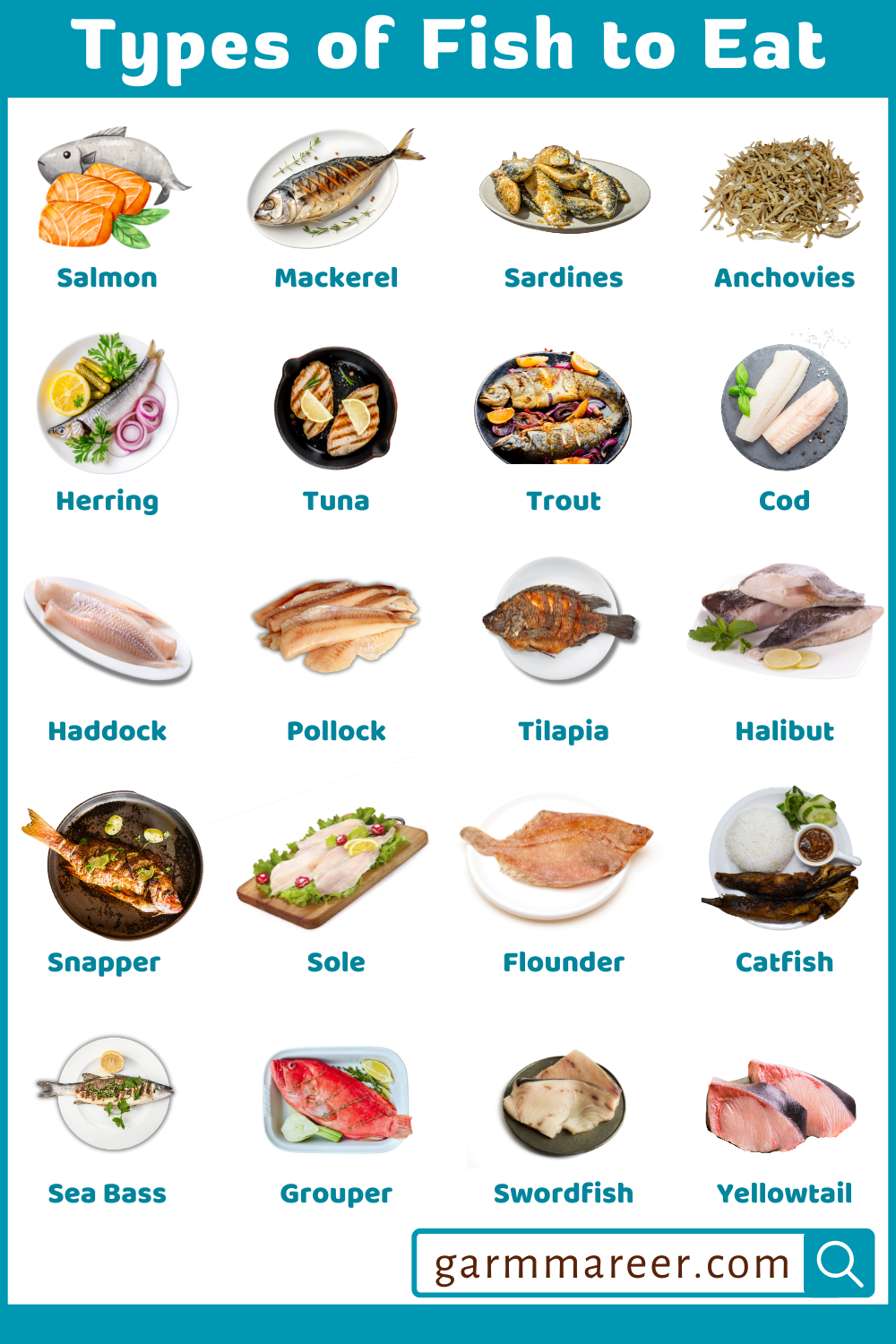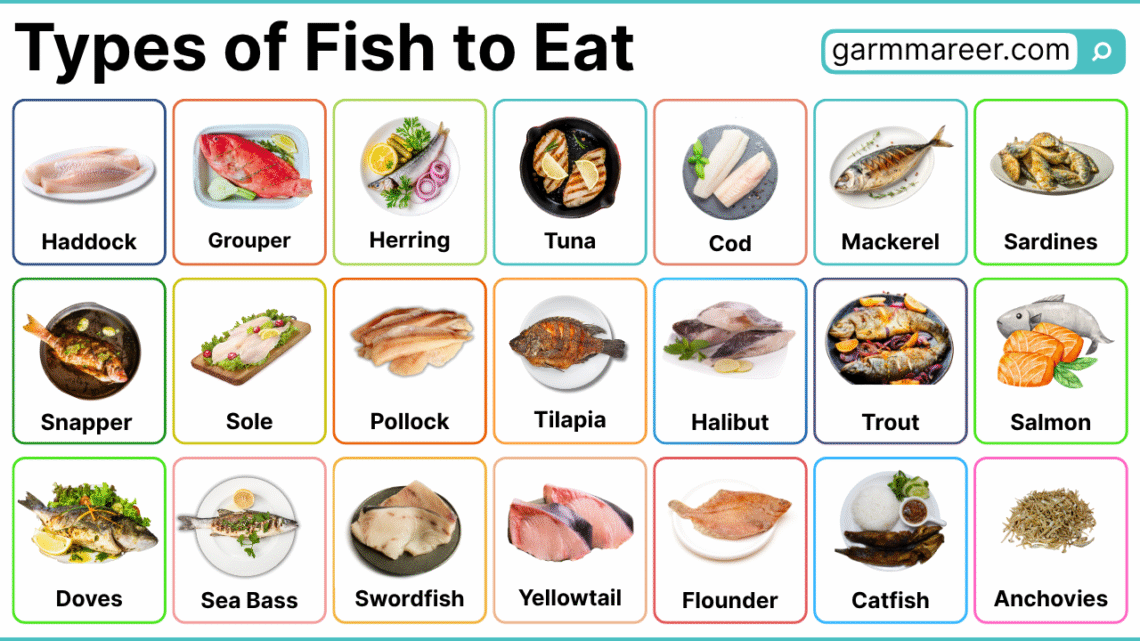Learning different types of fish to eat helps you talk about seafood choices, cooking styles, and menus wisely. Many names like salmon, trout, catfish, or tilapia pop up in recipes when you shop or read a menu.
In this post you will see names, culinary uses, and benefits of many fish. Knowing types of fish to eat makes it easier to choose in markets, restaurants, or when cooking at home.
Table of Contents
Eatable Fish Names and their Pictures
- Salmon: Rich in omega-3 fatty acids, this pink fish is excellent for grilling or baking.
- Tuna: Meaty and protein-packed fish, often enjoyed as steaks, sushi, or canned food.
- Mackerel: Oily, flavorful fish full of healthy fats; perfect for smoking or pan-frying.
- Tilapia: Mild-tasting freshwater fish that easily absorbs spices and cooks quickly.
- Catfish: Soft white flesh with a gentle flavor, best when fried or grilled.
- Cod: Lean, flaky fish commonly used in fish and chips or baked recipes.
- Trout: Freshwater favorite with delicate flavor, great for baking or pan-grilling.
- Sardine: Small oily fish rich in nutrients, usually canned or grilled for quick meals.
- Snapper: Firm saltwater fish with a sweet flavor, ideal for roasting whole.
- Bass: Mild and flaky fish that works well grilled, steamed, or baked.
- Haddock: White fish similar to cod, perfect for chowders and fried dishes.
- Herring: Fatty, flavorful fish often smoked, pickled, or served with breakfast.
- Grouper: Moist, firm flesh with a light flavor; great for grilling or baking.
- Barramundi: Buttery, mild white fish known for its clean taste and soft texture.
- Pomfret: Popular in Asian dishes; tender white flesh, often fried or steamed whole.
- Kingfish: Firm-textured and rich-tasting, commonly used in steaks and spicy curries.
- Rohu: Common South Asian freshwater fish with mild flavor, loved in curries and fries.
- Hilsa: Bengali delicacy with a distinct taste, often cooked in mustard sauce.
- Anchovy: Tiny salty fish used to add flavor to pizzas, salads, and sauces.
- Swordfish: Meaty fish with a firm texture, delicious when grilled into thick steaks.

Freshwater Edible Fish Species Names ( uses in cooking and edible )
Freshwater fish are those living in rivers, lakes, ponds, or streams. Below are many edible species and how they are used in cooking.
Common Freshwater Food Fish
These freshwater fish are well known and commonly eaten around the world:
- Tilapia: mild flavor, firm texture. Used for pan-frying, baking, grilling, or in stews.
- Catfish: dense flesh. Good for deep frying, grilling (with marinade), or fish cakes.
- Trout (e.g. rainbow trout): delicate and flavorful. Useful for grilling whole, baking in foil, or smoking.
- Carp: earthy taste. Often steamed in Asian cuisine, or made into fish balls, soups, or fried fillets.
- Bass (freshwater bass / largemouth): firm and mild. Great for grilling, sautéing, or poaching.
- Perch: soft and tender. Often breaded and pan-fried, or used in fish fillet dishes.
- Pacu: South American fish with sweet flesh. Used grilled or roasted.
- Pike: lean flesh and a bit bony. Often minced into fish patties, or baked whole with stuffing.
- Crucian carp: small freshwater fish. Used in soups, steamed, or lightly fried.
Mild-Tasting Freshwater Options
These choices are good when you prefer gentle flavor (less “fishy”) for kids or those new to fish:
- Tilapia: its mildness makes it versatile in many sauces.
- Trout (rainbow trout): fine texture and pleasant sweetness.
- Bass (freshwater bass): subtle flavor that takes on marinades.
- Perch: delicate and mild, ideal for light preparation.
- Carp (certain varieties, if well cleaned and prepared): milder when cooked in soups or with aromatics.
Best Freshwater Fish for Grilling or Frying
Some freshwater species hold up well under direct heat, making them ideal for grilling or frying:
- Catfish: thick fillets resist drying; great for crispy fry or grill.
- Bass: firm flesh handles grill bars or high heat.
- Trout (larger types): can be grilled whole or in halves.
- Pacu: hearty texture tolerates grilling.
- Perch: small fillets that crisp nicely in frying pans.
Saltwater Fish Eaten Worldwide
Saltwater (marine) fish live in oceans or seas. Many are staples of global diets, loved for flavor, nutrition, and versatility.
Best-Tasting Ocean Fish
These marine fish are widely regarded as delicious and prized in culinary traditions:
- Salmon (Atlantic, Pacific): buttery, rich. Used in grilling, smoking, sashimi, baking.
- Tuna (yellowfin, albacore, bluefin): firm and meaty. Great for steaks, searing, sushi/sashimi.
- Mackerel (Atlantic, king, Spanish): oily, full flavor. Often grilled, smoked, pickled.
- Sea bass (European sea bass, black sea bass): mild and tender. Pan-sear, roast, steam.
- Snapper (red snapper, yellowtail): lean and sweet. Baked whole, grilled, in curries.
- Cod (Atlantic cod, black cod): flaky and mild. Ideal for frying (fish and chips), stews, baking.
- Halibut: firm fillets. Good for broiling, grilling, poaching.
- Swordfish: dense and meaty. Excellent as steaks for grilling or broiling.
- Mahi-mahi: firm texture. Works well grilled, broiled, or pan seared.
- Flounder / Sole: delicate whitefish. Great for sautéing, steaming, or light frying.
Oily and Lean Fish Name
Types of oily and lean fish to eat is as follows:
Oily Fish Names and Benefits ( uses in cooking and edible )
Oily fish contain higher omega-3 fats and rich flavor. They are nutritious and tasty when cooked well.
- Salmon: rich in omega-3. Grill, smoke, or bake with skin.
- Mackerel: flavorful and oily. Smoke, grill, pan fry.
- Tuna: moderate oil. Sear, grill, sushi style.
- Trout (rainbow or lake): oily flesh. Good for roasting, smoking, grilling.
- Sardines: small but packed with oil. Grill whole, can or smoke.
- Herring: classic oily fish. Used pickled, grilled, smoked.
- Anchovy: intense flavor. Use in sauces, toppings, or fried.
- Swordfish (relatively): moderate oil, dense. Grill steaks.
Benefits: more omega-3 fatty acids, fat-soluble vitamins, richer taste, heart and brain health support.
Lean Fish Names and Uses in Cooking
Lean fish have less fat and delicate texture. They pair well with sauces and gentle cooking.
- Cod: mild, flaky. Ideal for fish and chips, stews, poaching.
- Flounder / Sole: very delicate. Steam, sauté, light fry.
- Snapper: mild and firm. Bake, steam, grill carefully.
- Bass (sea bass / freshwater bass): lean to moderate. Grill, sauté, roast.
- Pike: lean and firm. Best minced, baked, or stuffed.
- Tilapia: low oil content. Pan fry, bake, use in sauces.
- Perch: lean white flesh. Fry or sauté with light seasoning.
Popular Regional Edible Fish List
In different parts of the world, people favor certain fish species. Below are regional choices in bullet form (only fish names):
Asian Food Fish Choices
- Rohu
- Hilsa
- Pomfret
- Seer fish (king mackerel)
- Milkfish
- Catla
- Mahseer
- Snakehead (Channa)
- Tilapia
- Carp (various Indian carps)
European and Mediterranean Favorites
- Sea bass (European)
- Gilt-head bream (dorade / dorada)
- Sardine
- Anchovy
- Mackerel
- Skate
- Trout (rainbow, brown)
- Cod
- Turbot
- Grouper
American and Coastal Seafood Options
- Salmon
- Tuna
- Snapper
- Mahi-mahi
- Halibut
- Bass (striped bass, black sea bass)
- Grouper
- Flounder
- Redfish
- Trout (sea trout)
Nutritional Benefits of Eating Fish
Here is a table of a few fish and their nutritional highlights.
| Fish | Nutritional Benefit / Key Nutrients |
|---|---|
| Salmon | high in omega-3, vitamin D, protein |
| Mackerel | rich in healthy fats, B vitamins |
| Trout | omega-3, lean protein, vitamin B12 |
| Tuna | protein, selenium, vitamin B3 (niacin) |
| Cod | lean protein, phosphorus, B12 |
| Sardine | calcium, omega-3, vitamin D |
| Flounder / Sole | low fat, protein, phosphorus |
| Bass | protein, low saturated fat |
| Snapper | lean protein, potassium, magnesium |
| Carp | protein, essential amino acids, minerals |
Fish provide high-quality protein, omega-3 fatty acids, vitamins (like D and B12), minerals (iodine, selenium), and support heart, brain, and bone health. Eating a variety of species ensures you get a broad nutrient mix.
FAQs on Types of Fish to Eat
Ten tasty fish to eat are salmon, tuna, trout, cod, mackerel, sardine, tilapia, snapper, catfish, and halibut, rich in protein and nutrients.
Salmon is the best fish for health because it’s rich in omega-3 fatty acids, supports heart health, boosts brain function, and strengthens immunity.
Not always. Oily fish offer more omega-3s, but lean fish are good for lower fat diets and pair easily with flavors.
Yes, but adjust seasoning and cooking times, since saltwater fish often cook faster or have stronger flavors.
You May Also Like




